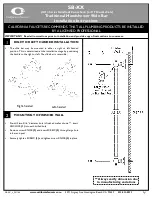
www.petsafe.net
15
The “Place” Command
This follows on from the Stay command. Prior to going out with your dog put a “place” mat or piece of
rug on the ground in your training area. A raised place platform 3 inches above the ground is sometimes
advantageous as it shows a clearly defi ned place. Make the place mat large enough for the dog to sit on and
lay down on it. The size is dependent upon the size of the dog.
1.
Go through Preparation for Training
2.
Go through the “Come On”, follow me routine for two or three minutes.
3.
Lead your dog to the Place mat and walk him over it. Guide him and let him explore this. Some dogs will
walk around it or even want to avoid it totally.
4.
Walk your dog over it comfortably about six to ten times.
5.
Now as you walk towards the place, say “Place” and point to it with your hand. Again let the dog walk
happily over the place. Do this 4 times or until the dog looks comfortable doing this.
6.
Walk towards the place, point and say “Place”. As your dog steps on the place tap the stimulation button
at the Recognition Level and say “Sit”. Praise as he sits.
7.
Wait fi ve seconds, say “Come On” and lead him away.
8.
Repeat 6 and 7 six times.
9.
Now walk towards the place, point and say “Place” and sit when he is on the place. Now say “Stay” and
go through the “Stay” training routine.
10. Do a “Sit” and “Stay” with your dog four times gradually increasing the time he has to stay on his place.
11. When confi dent, begin to walk slowly around your dog on his place. If he moves off his place, give him
the “Place” command and tap him on the collar as you take him back. Again ask him to “Sit” and Stay”
on his place mat.
12. Stop before your dog becomes tired and cannot concentrate – in other words stop when you are getting
good results.
13. Sit with your dog and be his friend for a few minutes and then put him away in his crate or a “safe”
room to remember the lesson, where he cannot misbehave.
As with the Stay command, always go back to your dog until he is consistently staying on his place. Increase
the time you can leave him, the distance you can be away from him and the number of times you can walk
around him gradually over days and even weeks. All dogs learn at different rates.
Eliminating Unwanted Behaviour
Eliminating unwanted and annoying behaviour should always be preceded by teaching your
dog what the collar means. Without introducing your dog to the collar and creating a basic
understanding of what the communication means your dog could become concerned, stressed and
react out of character. A sudden unknown stimulation can have your dog running away, hiding and
becoming fearful, therefore always introduce the collar to fi nd the recognition Level and create
misunderstanding from at least one training exercise such as “Come On” the follow me exercise. In
this exercise, once your dog has accepted the collar, you can say “Come On” with no stimulation,
if your dog ignores you press the “Bad Dog” Button and follow it with the stimulation. He will
now begin to understand the “Bad Dog” Button prior to you stopping misbehaviour by using the
stimulation as necessary.
Jumping Up on People
Dogs as puppies are often encouraged to jump up on people. When small no one minds but as they get
older then it can be not only annoying but damaging to the person being jumped on. Jumping up on
people should be discouraged from the very beginning and dogs should be shown the correct way to
Summary of Contents for comfortfit trainer
Page 65: ...www petsafe net 65 ...
Page 66: ...66 www petsafe net ...
Page 67: ...www petsafe net 67 ...
















































